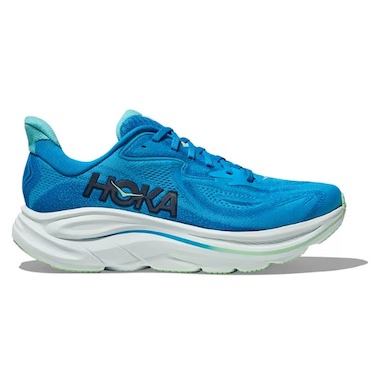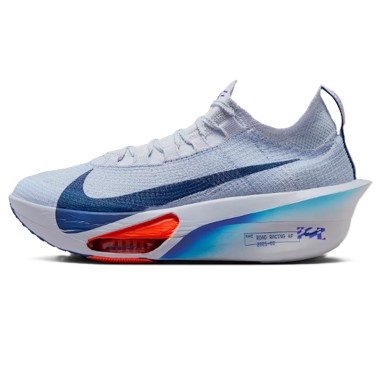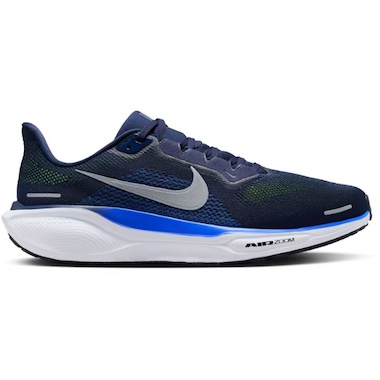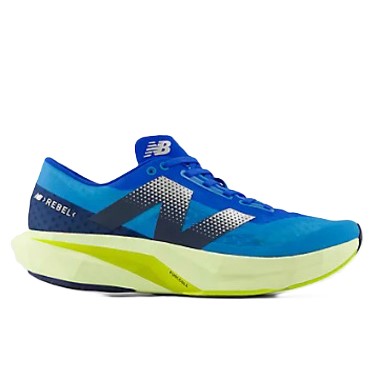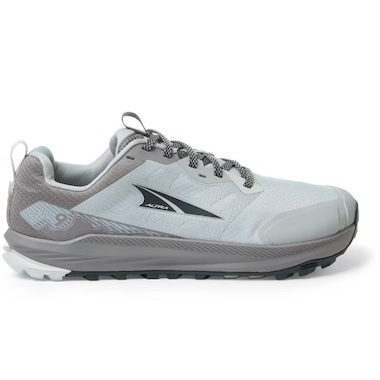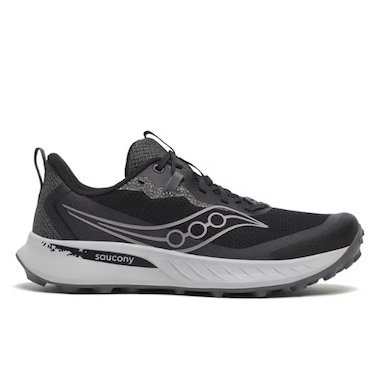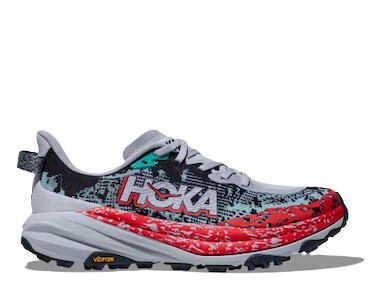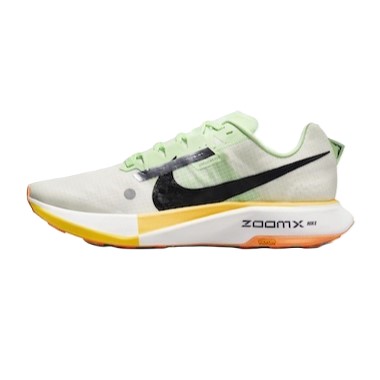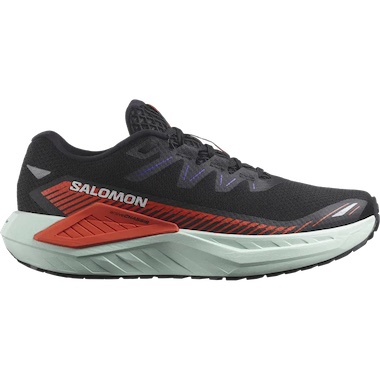
The Hoka Clifton 9 (right) and the Salomon Phantasm were two of iRunFar’s favorite road running shoes. Photo: iRunFar/Eszter Horanyi
As runners, there’s nothing more important than finding the best pair of running shoes for our feet. Shoes directly impact our experience on the roads and trails, our level of comfort, and, therefore, enjoyment. The good news is that hundreds of running shoe models are available today, meaning there’s something out there that can work for every type of runner and their specific goals.
The challenge is navigating this vast landscape and finding the best running shoes for you. That’s where we can help. At iRunFar, our editors continually research, evaluate, and compare all the running shoes on the market. Our team of shoe testers regularly assesses new and updated shoes for performance, durability, style, fit, and comfort.
For this guide, we combined our knowledge and experience with running shoes, compiled a list of dozens of shoes for testing, and logged at least 100 miles on each shoe. Our testers regularly run roads, trails, and paths, spanning a range of running abilities from novice to elite. We are spread out across the country, running on varying terrains and climates.
This guide is our one-stop shop for the best running shoes, whether you’re looking for a road, trail, or something even more specific. Our team selected the Hoka Clifton 10 as the best overall road shoe, while our trail runners opted for the Saucony Peregrine 15. For those who run on both road and trail in the same run, we recommend the Salomon Drx Defy Grvl.
Below, we’ve included buying advice to help you choose the right shoe, as well as answers to your frequently asked questions. Take a look at our breakdown of common running shoe terminology, and finally, learn how we chose our top picks by looking at our testing methodology.
Be sure to also check out our other running shoe guides, such as our Best Trail Running Shoes, Best Road Running Shoes, Best Stability Running Shoes, Best Cushioned Running Shoes, and Best Running Shoes for Mud.
Best Running Shoes
- Best Overall Road Running Shoe: Hoka Clifton 10
- Best Road Shoe for Racing: Nike Alphafly 3
- Best Everyday Trainer: Nike Pegasus 41
- Best Cushioned Road Running Shoe: New Balance FuelCell Rebel v4
- Best Stability Road Running Shoe: Brooks Adrenaline GTS 23
- Best Zero-Drop Running Shoe: Altra Lone Peak 9
- Best Trail Running Shoe: Saucony Peregrine 15
- Best Cushioned Trail Running Shoe: Hoka Speedgoat 6
- Best Trail Running Shoe for Racing: Nike Ultrafly
- Best Road-to-Trail Running Shoe: Salomon Drx Defy Grvl
Best Overall Road Running Shoe: Hoka Clifton 10 ($150)
- The cushion is plush without feeling mushy
- ‘Goldilocks’ in stack height, drop, and fit
- A do-everything shoe
Cons:
- The toebox isn’t wide enough for some
The Hoka Clifton 10 is one of the most popular shoes currently on the market. The primary reason is that it works for a wide range of runners, and there are several reasons for this. It is a neutral shoe with plenty of responsive cushioning at a moderate weight.
The heel-to-toe drop is also in the moderate range. This is one shoe that you can take out of the box and run for multiple hours without needing a break-in period. We call it our comfort shoe, meaning when we just want to go out and feed the soul by logging some daily miles, this is a shoe we grab.
Now in its tenth iteration, this version of the shoe underwent some slight changes. The one that most got our attention was an increase in heel-to-toe drop, going from 5 millimeters to 8 millimeters. Despite that slight increase, we didn’t notice a difference from the previous version. The breathable jacquard mesh top is breathable and highly comfortable.
The high stack height of the shoe mainly comes from the compression-molded EVA foam. Not surprisingly, considering Hoka essentially invented the maximum cushion market, this midsole foam is lightweight and incredibly responsive, resulting in a fun and comfortable ride.
The Hoka Clifton 10 remains our top choice for road running shoes due to its exceptional comfort, versatility, durability, and value. It is good for beginners training for their first 5K to experienced marathoners logging daily miles and long runs. It will last hundreds of miles. And despite a $5 price increase from the Clifton 9, it’s still a reasonably priced running shoe.
To learn more, check out our Hoka Clifton 10 review.

The Hoka Clifton 10 is our top choice for road running shoes. Photo: iRunFar/Nathan Allen
Claimed Weight (U.S. men’s 10): 9.8 ounces (278 grams) | Stack Height: 42/34 millimeters heel/toe (men’s), 29/24 millimeters heel/toe (women’s) | Drop: 8 millimeters
Shop the Men's Hoka Clifton 10Shop the Women's Hoka Clifton 10
Best Road Shoe for Racing: Nike Alphafly 3 ($285)
- Top-of-the-line road racing shoe
- Excellent energy return for efficiency in longer distances
- Still stable
Cons:
- Expensive
The Nike Alphafly 3 is a made-for-speed racing shoe. Launched in 2020, the Alphafly quickly became one of the most popular super shoes available. And that’s for a good reason. Like the Nike Vaporfly, it was a highly efficient, bouncy, and fast road racing shoe that had folks setting personal bests in road races up to the marathon. Three iterations later, the shoe still slaps, so we named it our favorite marathon running shoe. The third version does everything the second did but weighs more than an ounce less.
Three key factors make this one of the fastest marathon shoes we’ve encountered. First is Nike’s Air Zoom cushioning. We won’t get into the weeds, but the cushioning system — first launched in 1995 — condenses under pressure from the foot and springs back, literally giving the shoe spring or bounce. Nike combines the two forefoot Air Zoom units with its midsole ZoomX foam for excellent energy return. The third piece of the puzzle is the carbon plate running the length of the foot that provides propulsion.
Besides shaving more than an ounce off each shoe in the men’s version, Nike increased the width of the carbon plate in its newest version. This made an already stable shoe even more stable. Nike also added more ZoomX midsole to the bottom of the shoe and updated the upper to increase breathability. So far, we love the improvements. We think it feels more propulsive and responsive than previous versions and can’t wait to take it out for a spring marathon.
Claimed Weight (men’s): 7.4 ounces (210 grams) | Drop: 8 millimeters
Shop the Men's Nike Alphafly 3Shop the Women's Nike Alphafly 3

The Nike Alphafly 3 is our top choice for road racing shoes. Photo: iRunFar/Eszter Horanyi
Best Everyday Trainer: Nike Pegasus 41 ($155)
- Can do it all
- Comfortable
- Durable
- Lightweight
Cons:
- Slight price increase from the previous version
The Nike Pegasus 41 is an incredibly versatile running shoe. It’s so versatile, it was the only shoe iRunFar’s founding editor, Bryon Powell, ran in on his way to winning the 2024 Ultra Gobi 250-mile ultramarathon. The course included paved and dirt roads, as well as off-trail sections. Powell found them lightweight, breathable, and able to go a very long way.
His experience is similar to our other testers’ experience in the shoes. These are do-it-all shoes that are durable and will last a long time. The shoe’s versatility starts with the rubber outsole. The waffle-inspired pattern is grippy, featuring tiny lugs that handle dirt, crushed rock, and gravel effectively.
This shoe’s energy return is also excellent, thanks to the ReactX midsole foam and Air Zoom units at the heel. Nike upgraded the upper for boosted breathability — a feature Powell appreciated during his 250-mile ultra. We also found the upper very plush and comfortable.
The Pegasus 41 is an excellent shoe for anyone who runs on any surface besides super technical or steep trails. And as Powell discovered, it’s good for anyone training for anything from a 5K race up to a 250-mile one.
To learn more about the shoe, check out our Nike Pegasus 41 review.
Actual Weight (U.S. men’s 10): 9.9 ounces (281 grams) | Drop: 10 millimeters
Shop the Men's Nike Pegasus 41Shop the Women's Nike Pegasus 41

The Nike Pegasus 41 are some of the most versatile running shoes we’ve tested. Photo: iRunFar/Eszter Horanyi
Best Cushioned Road Running Shoe: New Balance FuelCell Rebel v4 ($140)
- Excellent weight-to-cushion ratio
- A ton of fun
- Good for all sorts of runs and could be a racing shoe
- Excellent value
Cons:
- Could be a bit more flexible, but we’re nitpicking
We put the New Balance FuelCell Rebel v4 as our best cushioned shoe, and with a stack height higher than 30 millimeters, it definitely fits into the maximum cushion category. But we don’t want to limit New Balance’s newest version of the FuelCell Rebel to just a cushioned shoe.
This is truly one of the best do-everything road running shoes we’ve tested. New Balance’s FuelCell foam is lightweight, propulsive, and a ton of fun. With a claimed weight of 7.5 ounces in the men’s version, this shoe is excellent for daily runs, speed workouts, long runs, and even races.
We also appreciated the comfort of this shoe. The toebox is roomy, and the upper, which New Balance calls FantomFit, is soft and comfortable. With a 6-millimeter drop, this shoe will work for most runners. Since this shoe is approachable in price, feel, and performance, we view it as an excellent choice for runners training for their first 5K to marathoners going for a Boston qualification. It’s genuinely the Swiss Army Knife of road running shoes.
Claimed Weight (men’s): 7.5 ounces (212 grams) | Drop: 6 millimeters
Shop the Men's New Balance FuelCell Rebel v4Shop the Women's New Balance FuelCell Rebel v4
Best Stability Road Running Shoe: Brooks Adrenaline GTS 23 ($140)
- High level of support
- Comfortable and breathable upper
Cons:
- Lack of pop
- It feels stiff out of the box
The Brooks Adrenaline GTS 23 is a stability shoe that provides a balance of cushion and support with a traditional shape and fit that works well for a variety of feet. The line of shoes has been a favorite among overpronating runners for over twenty years, and this model is ideal for daily running. Whether you’re training for a marathon or logging miles for pure enjoyment, there’s a good chance this shoe will work for you.
Brooks’ GuideRails technology provides the shoe’s stability with two firm pieces of foam inside the shoe, on each side of the heel, that prevent the foot from rolling too far inward. The added foam helps stabilize the ride without overcorrecting a runner’s natural gait. While the shoe feels good out of the box, it gets even more comfortable as it breaks in.
We found the cushion to be soft and the ride smooth, but it also lacks the springiness we prefer during speed workouts. That said, we highly recommend this shoe for anyone seeking great support and moderate cushion for everyday road running.
We named this shoe our top choice in our Best Stability Shoes guide.
Actual Weight (U.S. men’s 9): 10.6 ounces (301 grams) | Drop: 12 millimeters
Shop the Men's Brooks Adrenaline GTS 23Shop the Women's Brooks Adrenaline GTS 23
Best Zero-Drop Shoe: Altra Lone Peak 9 ($140)
- Good balance of support and cushion
- Comfortable out of the box
Cons:
- Zero drop isn’t for everyone
- Less responsive and snappy
There’s probably not a more popular zero-drop shoe than the Altra Lone Peak 9. You could probably call it a bit of a cult classic for at least two reasons. For one, people outside of running love it as it’s a solid hiker or everyday shoe for folks trying to build up lower-leg and foot strength. More pertinent to this site and trail runners, it’s an excellent zero-drop shoe for running on trails. And, folks who love wide toe boxes also tend to love Altra’s Original Footshape fit.
There are a few updates to the newest version of the Lone Peak. Starting at the top, Altra employs a 100% recycled ripstop upper with no-sew overlays, meaning that there are no stitches that could cause rough spots. Our main tester of the Lone Peak reported that the upper was breathable and durable, and also noted it was warmer than many other shoes. Boosting the durability is increased toe bumper protection.
Moving down to the midsole, we applaud that Altra stays true to its relatively low stack height in this age of maximum cushioned shoes. The updated Altra Ego midsole is lighter than the previous version, and it combines with the StoneGuard insert to provide a durable, protected, close connection with the ground.
Altra changed nothing with the outsole, employing its versatile MaxTrac outsole. Why change a good thing, right? The MaxTrac is a versatile outsole that works on gravel roads, road-to-trail approaches, and more technical singletrack.
Read our full Altra Lone Peak 9 review.
Actual Weight (U.S. men’s 10.5): 11.2 ounces (319 grams) | Drop: 0 millimeters
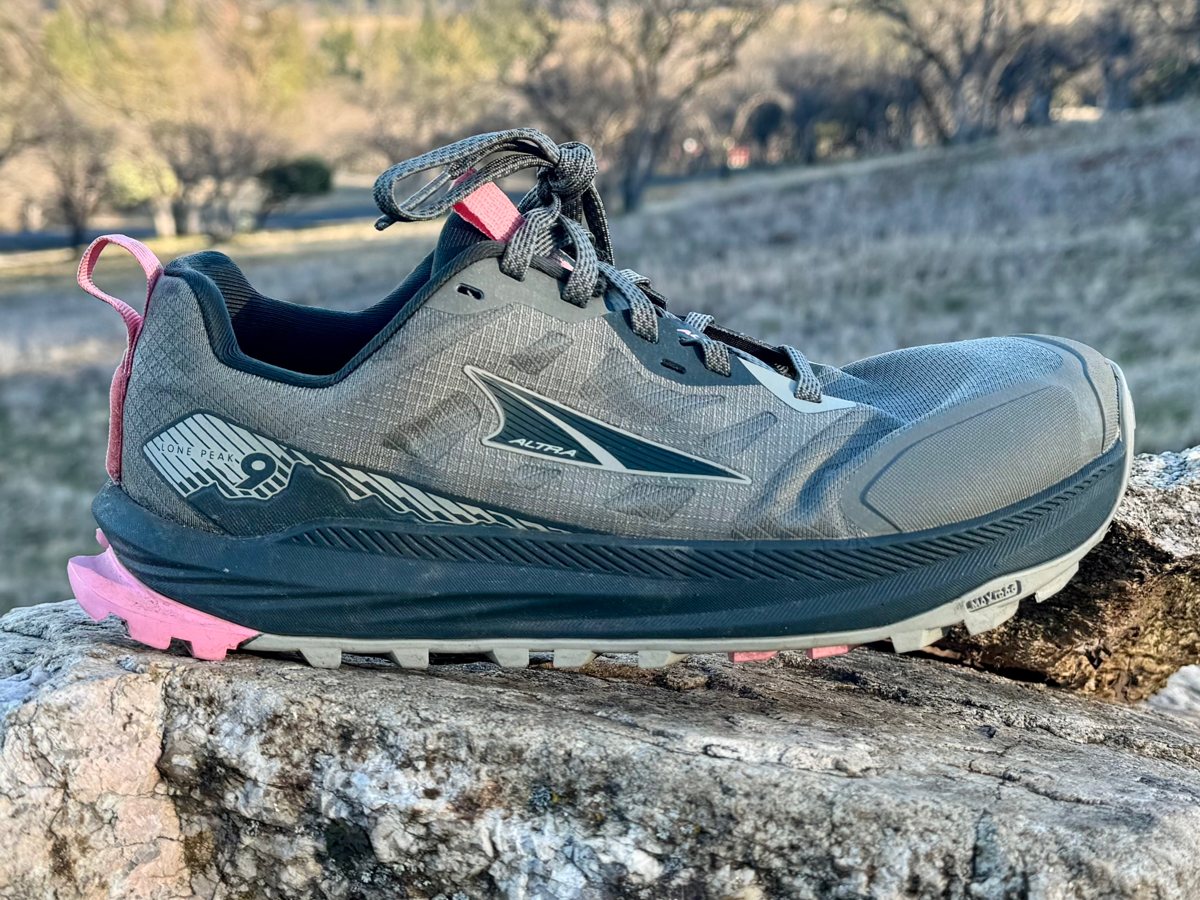
The Altra Lone Peak 9. Photo: iRunFar/Molly Schmelzle
Shop the Men's Altra Lone Peak 9Shop the Women's Altra Lone Peak 9
Best Trail Running Shoe: Saucony Peregrine 15 ($140)
- Great all-around trail shoe
- Reasonable price
- Lightweight
Cons:
- Loses traction on wet surfaces
With over a decade of design behind it, the Saucony Peregrine 15 is a well-loved and great everyday trail shoe. While the Altra Lone Peak 9 is a fairly specific shoe, designed for a specific type of trail runner and hiker, the Saucony Peregrine 15 takes the opposite approach, offering a very approachable and versatile shoe suitable for both beginner trail runners and experienced ultrarunners.
Throughout the line’s history, it’s migrated from a trail racing shoe to something more in line with a classic, everyday trail shoe, which we appreciate. Simply put, it is a very basic and straightforward trail running trainer, in the best possible way.
The upper is a standard mesh, which our tester preferred over the engineered mesh that brands increasingly use in their running shoes. The reason? The standard mesh isn’t as flexible, which our tester said was actually a good thing on the trails, as it holds your foot more in place on uneven and rough terrain. The width of the shoe is standard, although Saucony does offer a wide version. The toebox is medium width, providing some room for toes to splay, but not as much as in an Altra or Topo shoe.
The 4-millimeter drop is very approachable and will work for many people. The 5-millimeter lugs provide decent traction on dry ground and are suitable for some wet and soft mud. The Peregrine is a proven shoe at a moderate price, offering excellent value. We’ve found that these shoes will easily last into the 400- to 500-mile range, meaning you’ll be able to get many runs out of them.
Read the full Saucony Peregrine 15 review.
Actual Weight (U.S. men’s 9): 9.8 ounces (278 grams) | Drop: 4 millimeters
Shop the Men's Saucony Peregrine 15Shop the Women's Saucony Peregrine 15

Running in the Saucony Peregrine trail running shoes in California’s Ventura County. Photo: iRunFar/Eszter Horanyi
Best Cushioned Trail Running Shoe: Hoka Speedgoat 6 ($155)
- Exceptional traction
- Perfect cushion
Cons:
- It may be too much shoe for some
- Less foot lockdown for narrower feet than in previous versions
Unsurprisingly, the Hoka Speedgoat 6 tops our list of the best trail running shoes. The line of shoes was a hit when it launched, and it has only improved over the years. With a breadth of well-cushioned trail shoes on the market, they continue to stand out in terms of comfort and performance. The cushioning isn’t so over-the-top as to get in the way for many trail runners, and the outsole features generous lugs made from Vibram Megagrip, which yields strong traction in most conditions, including mud and snow.
The most significant upgrade to this shoe is a new super-responsive midsole compound. Hoka did this while also dropping the weight of the shoes by a few grams. The shoe feels relatively light and nimble for its size, which we felt added to its versatility. The most recent update includes a simple and smooth upper that’s more durable and reduces the likelihood of developing hotspots.
Read the full Hoka Speedgoat 6 review.
Actual Weight (U.S. men’s 9): 9.8 ounces (278 grams) | Drop: 5 millimeters (but less relevant with so much midsole)
Shop the Men's Hoka Speedgoat 6Shop the Women's Hoka Speedgoat 6

Alli Miles runs in the Hoka Speedgoat 6 trail running shoes in California’s Santa Monica Mountains. Photo: iRunFar/Eszter Horanyi
Best Trail Running Shoe for Racing: Nike Ultrafly ($260)
- Super fast
- Excellent responsiveness
- Good comfort
Cons:
- Expensive
The Nike Ultrafly is the brand’s super shoe for the trails. From top to bottom, it’s one of the most teched-out trail racing shoes currently available. Starting at the bottom, the Ultrafly features Vibram’s Megagrip Litebase outsole. It’s probably one of the lightest true trail running outsoles available with significant traction. The chevron lug pattern is good for all trail surfaces, from flat dirt trails to rocky, steep, and technical trails.
But what sets this shoe apart from others — both in performance and price — is the carbon Flyplate sandwiched between Nike’s ZoomX foam. The midsole creates a very responsive and efficient stride. Lastly, the upper features Nike’s Vaporweave mesh, which we have found to be very comfortable and breathable.
There’s never been a better time to be alive when it comes to running shoe technology and performance. And the Nike Ultrafly is a prime example of how far shoes have come. It is our favorite trail racing shoe on the market and is a ton of fun to run in.
Read our full Nike Ultrafly review.
Actual Weight (U.S. men’s 9): 10.6 ounces (300 grams) | Drop: 8.5 millimeters
Shop the Men's Nike UltraflyShop the Women's Nike Ultrafly

Running in the Nike Ultrafly trail racing shoes in California’s Santa Monica Mountains. Photo: iRunFar/Eszter Horanyi
Best Road-to-Trail Running Shoe: Salomon Drx Defy Grvl ($140)
- Comfortable
- Ideal outsole for all surfaces
- Excellent value
Cons:
- Not a great shoe for faster runs
The Salomon Drx Defy Grvl running shoe is an excellent crossover shoe for anyone taking approaches to trails on roads or splitting training time between pavement and trails. As its name implies, this is technically Salomon’s gravel shoe, with an outsole inspired by gravel bike tires. However, we found it not only good for gravel roads but also excellent for transitioning from gravel and pavement to more technical trails.
Salomon uses light guiding technology to add some stability without straying into the realm of full-stability shoes. The proprietary energyFOAM cushioning provides a responsive, comfy, and fun ride. The shoe’s 8.4-ounce weight is light, and the 8-millimeter drop works for many runners.
You may wonder what sets this shoe apart from the Nike Pegasus 41, another highly versatile option. The simple answer is we didn’t feel confident putting the Pegasus 41 on steeper or more technical trails. We had more confidence in Salomon’s gravel shoes on trails with looser rocks and a steeper pitch.
Another way to think of it is if you run on technical trails but also run on gravel, pavement, or dirt paths, the Salomon Drx Defy Grvl is probably the better option. But if you stay on relatively flat paths that are not technical and don’t have a lot of loose rocks, the Pegasus 41 is probably the pick.
Actual Weight (U.S. men’s 9): 8.4 ounces (239 grams) | Drop: 8 millimeters
Shop the Men's Salomon Drx Defy GrvlShop the Women's Salomon Drx Defy Grvl

Gravel bike tires inspire the outsole of the Salomon Drx Defy Grvl and can handle both dirt and pavement with ease. Photo: iRunFar/Eszter Horanyi
Comparing the Best Running Shoes
| SHOE | PRICE | WEIGHT | DROP | USE |
| Hoka Clifton 10 | $150 | 8.9 ounces | 8 millimeters | Road/training |
| Nike Alphafly 3 | $285 | 7.4 ounces | 8 millimeters | Road/racing |
| Nike Pegasus 41 | $155 | 10.4 ounces | 10 millimeters | Road/training |
| New Balance FuelCell Rebel v4 | $140 | 7.5 ounces | 6 millimeters | Road/training/racing |
| Brooks Adrenaline GTS 23 | $140 | 10.6 ounces | 12 millimeters | Road/training |
| Altra Lone Peak 9 | $140 | 10.7 ounces | 0 millimeters | Trail/training |
| Saucony Peregrine 15 | $140 | 9.8 ounces | 4 millimeters | Trail/training |
| Hoka Speedgoat 6 | $155 | 9.8 ounces | 5 millimeters | Trail/training |
| Nike Ultrafly | $260 | 10.6 ounces | 8.5 millimeters | Trail/racing |
| Salomon Drx Defy Grvl | $140 | 8.4 ounces | 8 millimeters | Road/trail/training |
Running Shoe Terminology
- Heel-to-Toe Drop – Also known as offset or drop, it refers to the height difference, measured in millimeters, between a shoe’s heel and forefoot. For example, a shoe with a 35-millimeter stack height under the heel and a 25-millimeter stack height under the forefoot has a 10-millimeter drop.
- Midsole – A layer of foam that connects a shoe’s upper to the shoe’s outsole.
- Upper – The top of the shoe, including the entirety of the shoe above the sole.
- Outsole – This is the bottom-most layer of a shoe that contacts the ground. It’s generally a rubber or rubber-like compound.
- Rock Plate — A layer of deformation-resistant material, such as a plastic sheet or carbon plate, that sits between the outsole and the sock liner. It protects the bottom of the foot from rocks, roots, and other trail debris. Rock plates vary in length and may cover the entire foot or just the forefoot.
- Lugs – The material protrusions on the bottom of an outsole. While road running shoes often have minimal lugs, trail shoes generally have lugs measuring 3 to 6 millimeters. Some trail shoes designed specifically for muddy conditions can have lugs as deep as 8 to 12 millimeters! Take a look at our best trail running shoes for mud guide for the luggiest of trail shoes.
- Toebox – The forward area of a shoe around your forefoot. Toeboxes tend to be narrower in shoes aimed at faster or more technical running, while many runners prefer roomier toeboxes as the length of their runs increase to multiple hours. For wider toeboxes, check out shoe brands Altra and Topo.
- Stack Height – The maximum amount of shoe material between the foot and the ground.
- Arch Profile – Also called arch height, it describes how much of your foot touches the ground when you stand. Knowing your arch profile can help you understand how your foot absorbs impact when you run, including pronation and supination, and what injuries are common to each arch type. You can determine your arch profile — and whether it’s low, medium, or high — by dipping your feet in water and standing on a piece of cardboard. Note that your arches may not be the same profile and can change over time.
- Pronation – The natural inward collapse of the foot’s arch as it absorbs and distributes impact during running or walking.
- Overpronation – When the arch’s inward collapse exceeds the normal range. This can lead to pain in the arches, ankles, Achilles tendons, shins, outer knee, and/or outer hip.
- Supination – Also known as underpronation, it occurs when the arch barely collapses, allowing the outside of the foot to absorb the impact during running or walking. Supination is often associated with high arches and can be linked to plantar fasciitis and/or pain in the pelvis and lumbar spine.

The New Balance FuelCell Rebel v4 (left) is one of our favorite road running shoes. You can use it as an everyday trainer, workout shoe, or racing shoe. Photo: iRunFar/Eszter Horanyi
Buyer’s Guide: How to Choose Running Shoes
Choosing Between Road Running Shoes and Trail Running Shoes
While in the end, shoes are shoes, and you can run on roads in trail shoes and trails in road shoes, several distinct differences between the designs make each uniquely good for different types of running. Choosing the best running shoes for your individual needs is important.
Road shoes, like the New Balance FuelCell Rebel v4, have smooth outsoles and are meant for pavement. They’re also generally lightweight and breathable. Trail shoes like the Hoka Speedgoat 6 will have beefy lugs on the outsoles for gripping natural surfaces like rocks, mud, and dirt. Trail running shoes sometimes also have additional protective features like rock plates and extra material around the toebox.
If you primarily run on the roads, trail shoes are probably overkill — they’ll feel too clunky or sticky. If you take road shoes onto the trails, you’ll sacrifice grip and likely compromise the shoe’s durability. If you run on both roads and trails throughout the year, we recommend having at least one pair of road running shoes and a dedicated pair of trail shoes.
Several shoe options, including the Saucony Peregrine 15, will run comfortably on pavement while still providing sufficient grip on trails. Additionally, some shoes, such as the Salomon Drx Defy Grvl, are designed to handle both dirt and pavement with ease.
Running Volume
Running volume can play directly into how many running shoes you purchase each year and how many different running shoes you rotate through at a given time. If your primary activity is running and you do it consistently, you may cover anywhere from 1,200 to 2,500 or more miles per year. That mileage alone will easily take you through five to eight pairs of running shoes per year.
If that sounds like you, you’re probably committed enough to running that it’s worth keeping a few different styles of shoes on hand at a given time — perhaps a pair for the trails and one for the roads, and maybe some dedicated shoes for workouts and races, like the Nike Alphafly 3, or highly cushioned or supportive recovery run shoes, like the Brooks Adrenaline GTS 23. The Nike Pegasus 41 is a great workhorse shoe that will stand up to everyday training on a variety of different surfaces.
On the other hand, if you’re running a couple of times per week or running to supplement another primary sport, like ski touring, cycling, or rock climbing, you don’t necessarily need a quiver of running shoes. Instead, choose a high-quality pair or two that fit well and will best suit your needs, whether you’re running on roads, trails, or both.
The Salomon Drx Defy Grvl excels on gravel, but in our experience, it also performs well on trails and pavement. Then, keep track of the miles you put on your shoes or monitor their wear so that you’re ready to replace them when they’ve become too packed or broken down.
Running Speed
Running speed is relative, but how you like to feel when you run can influence the style of shoes you choose. The best running shoes are the ones you love to put on. If you love to feel fast and light, regardless of your actual pace, opt for a shoe with a firmer cushion that will feel bouncy and responsive.
If you prefer to run at a relaxed, easy pace and prioritize comfort above all else, choose shoes with more cushion and a softer, more plush midsole, even though you’ll lose responsiveness and ground feel. If you like to run fast and easy, like many of us, go with a shoe like the New Balance FuelCell Rebel v4 for roads or the Saucony Peregrine 15 for trails that balance comfort and rebound.
Alternatively, keep a few different shoes in your rotation to pick the best shoe for the experience you want on a particular day. We call the Hoka Clifton 10 our comfort shoe because they’re perfect for going out and running for the sheer joy of it.
Stability Versus Neutral Support
Neutral shoes allow the feet to move and flex naturally, while stability shoes guide the foot and help prevent overpronation. If possible, have an expert at a local running specialty store examine your gait before purchasing running shoes. Most people pronate to some extent, but if you overpronate, where your feet roll significantly inward after impact with the ground, you might consider a stability shoe. Stability shoes might also help if you’re prone to Achilles tendinitis, runner’s knee, or shin splints.
Another way to determine if you need stability shoes is to look at the wear pattern on the bottom of your current running shoes. If your shoes’ inward, or medial, side has more wear than the rest of your outsoles, you probably need stability shoes.
Lastly, consider the height of your arches. It’s not always the case, but a general rule is that individuals with low or flat arches tend to benefit more from stability shoes than those with medium or high arches.
Some of our favorite neutral road running shoes include the Nike Pegasus 41, New Balance FuelCell Rebel v4, and Hoka Clifton 10. Our favorite stability shoe is the Brooks Adrenaline GTS 23, and the Salomon Drx Defy Grvl has some light stability features. Learn more in our best stability road running shoes guide.
Fit
Running shoes should fit comfortably, not create hot spots, and keep your toes comfortable. For any running shoe, measure the length of your foot in inches and then size up a half to a full size. When trying on a shoe, leave about a thumb’s width of space between the end of your longest toe and the end of the shoe.
While there can be slight differences between brands, most are fairly standardized. A good fit will allow your toes to splay and wiggle some, but keep your feet from sliding around inside the shoe. The Altra Lone Peak 9 has a wide toebox, providing extra room for your toes.
You’ll also want to know the width of your foot. You don’t want any part of your foot hanging off the midsole. Many shoe brands — like Hoka, Brooks, and New Balance — offer standard and wide-width models of certain shoes to fit more foot sizes and styles. Getting the correct width is crucial to comfort and shoe longevity.

Alli Miles runs in the Hoka Speedgoat 6 shoes — our favorite trail running shoes. Photo: iRunFar/Eszter Horanyi
Toebox Shape
Similar to shoe cushioning, the toebox shape and size are personal preferences. Running shoe toeboxes tend to be classified as narrow, medium, and wide. If you prefer a snug fit around your toes, opt for a narrow or medium-sized toebox. But if you like some wiggle or splay room for your toes, pick a shoe, like the Altra Lone Peak 9, with a wide toebox. Wider toeboxes can help prevent blisters between your toes and help keep your toes happy as the miles ramp up.
In this guide, the Brooks Adrenaline GTS 23 for the road and Saucony Peregrine 15 for the trail are examples of shoes with a fairly traditional toebox that’s not exceedingly narrow or wide. Topo and Altra are brands known for making shoes with a particularly wide toebox that allows feet to relax and for toes to spread out comfortably.
Heel-to-Toe Drop
The heel-to-toe drop is the difference in stack height of a shoe from the heel to the toe. Stack height refers to the distance between your foot and the ground, encompassing both the midsole and outsole. A typical heel-to-toe drop falls in the 6- to 10-millimeter range.
Choosing drop is a personal preference, though there are some things to consider. For example, if you’re a hard heel striker, a higher heel stack height and drop might feel better and help with a smoother transition from the heel to the front of your foot. The Brooks Adrenaline GTS 23 has a very high 12-millimeter drop.
On the other hand, a lower drop can help lengthen posterior muscles and tendons, such as the glutes and hamstrings, and alleviate lower back tightness. That said, if you have had Achilles tendon issues or chronically tight calf muscles, a zero-drop shoe like the Altra Lone Peak 9 may not be the best choice.
If you’re transitioning to a shoe with a different amount of drop than you’re used to, it’s important to change gradually by slowly cycling the shoe into your rotation.
Arch Support
Every person’s feet and ankles move slightly differently throughout the various phases of their gait. A foot’s arch will naturally collapse slightly throughout a stride for shock absorption. The entire foot and ankle roll inward if an arch collapses too much and overpronates.
People who overpronate often have issues with their ankles, Achilles tendons, shins, knees, and/or hips. If you overpronate, you may want to consider a stability shoe, such as the Brooks Adrenaline GTS 23. The Salomon Drx Defy Grvl also provides some extra stability compared to a neutral shoe.
Some people have high arches that don’t collapse enough during their stride, and this is called underpronation or supination. Underpronation puts all of the impact on the outer part of the foot and can cause plantar fasciitis, pain in the pelvis, and issues with the lumbar spine.
The shape of your arch and how it moves throughout your stride determine the level of arch support you need in a shoe. Visiting a running store to have your gait analyzed is the best way to determine if you need extra arch support to stay injury-free and running comfortably.

Alli Miles runs in the Nike Ultrafly trail racing shoes, our favorite trail racing shoes available. Photo: iRunFar/Eszter Horanyi
Waterproof Versus Breathability
Some trail shoes, such as the Saucony Peregrine 15, are available in waterproof versions. In most cases, runners do not need waterproof trail running shoes, as they often cause more issues than they solve. If you’re interested in waterproof shoes, take a look at our Best Waterproof Running Shoes guide.
Waterproof shoes may keep your feet dry if moisture is on the ground, such as dew or shallow puddles. Likewise, a waterproof shoe can keep your feet dry if an inch or two of snow is on the ground. However, if it’s actually raining, water will run down your leg, into the shoe through the ankle collar, and stay in your shoe with nowhere to drain. In most situations, it’s better to have a breathable trail shoe, like the Hoka Speedgoat 6, which has a nice, light upper that drains and dries quickly.
That said, if you feel the need for waterproof trail shoes, many popular trail shoe models are available in waterproof versions, including the Brooks Cascadia 16 GTX, Salomon Speedcross 6 Gore-Tex, and Nike Pegasus Trail 4 Gore-Tex.
Why You Should Trust Us
The iRunFar team includes road, trail, and ultrarunners with 150-plus years of running experience. This guide is the culmination of extensive, ongoing research by iRunFar’s gear editors, year-round testing that involves putting a combined thousands of miles on dozens of running shoes, and input from iRunFar readers. We’ve tested endless shoes to provide options that allow you to choose the best running shoes for you.
At iRunFar, we test all types of shoes on a variety of terrains. Whether we’re testing cushioned trail shoes, road shoes, or mud shoes, our testing team carefully researches the top options currently on the market before narrowing down a list of shoes for testing. We take shoes out in all conditions and run in them for enough miles to get a good idea of their durability — usually at least 100 miles and oftentimes up to 300 or more.
We assess shoes for their overall fit and performance, as well as their outsole, midsole, and upper. Multiple testers wear shoes on as many surfaces as possible to test traction and stability.
This guide draws on shoe testing in various categories to identify the best of the best on the market today. We update this guide regularly as shoes are updated and new options arrive on the market.

Trail shoes have specific features to protect your feet and provide traction on all types of surfaces. Photo: iRunFar/Eszter Horanyi
Frequently Asked Questions About Running Shoes
What is a road running shoe?
A road running shoe will excel on smooth surfaces. The smooth outsoles generally lack the lugs and rock protection that trail running shoes provide. Road running shoes can come with a variety of cushion levels to accommodate different running needs. Some will be lively and snappy for speed workouts, while others are comfortable enough to run endless miles on hard surfaces. Our favorite road shoes on the market include the Hoka Clifton 10, New Balance FuelCell Rebel v4, and Brooks Adrenaline GTS 23.
What are the main differences between road running and trail shoes?
The most significant difference between road running and trail shoes is the outsoles. While the lugs and sticky rubber of trail shoe outsoles should provide purchase on a wide variety of surfaces, including hardpack, loose rocks, mud, and more, road shoes tend to have very smooth outsoles. This allows them to be lighter than trail shoes and more comfortable to run on flat and smooth surfaces, namely pavement and dirt roads.
The uppers of road shoes may also be less durable than trail shoes since they have to withstand much less abuse from rocks and other trailside debris. Gravel bike tires inspire the Salomon Drx Defy Grvl outsole and can work on gravel, trails, and pavement.
Can I run on trails in road running shoes?
With their relatively smooth outsoles, road shoes offer little grip on anything other than pavement, making them hazardous to use on trails. Slipping off a trail can lead to injury, and while road shoes are lighter, you may be tempted to race in them; however, it’s generally not worth the risk.
That said, road shoes may be perfectly adequate and a good choice on gravel or hard-packed trails that aren’t too steep. This is especially true if you run on pavement to get to dirt trails. The Salomon Drx Defy Grvl and Nike Pegasus 41 are both highly versatile shoes that can work on a variety of surface types.

Alli Miles of iRunFar (front) tests trail shoes on trails in the Fruita desert in Colorado. Photo: iRunFar/Eszter Horanyi
What are the best road running shoes for beginners?
If you’re new to running, consider visiting your local specialty running shop to find the best running shoes tailored to your needs. There, they’ll be able to measure your feet, discuss the different types of surfaces you want to run on, and analyze your gait. A running expert can assess your arch height and help you choose a shoe that suits your feet, running style, and goals.
If you don’t have a running shop in your area, several shoes will fit a wide range of runners. Starting with a fairly average shoe will allow you to learn about what you like and dislike in shoes so that you can make a more informed purchase with your next pair.
If you’re looking for a shoe with fairly average measurements throughout and that will fit a variety of feet and running styles, consider the Saucony Peregrine 15 for trails or the Nike Pegasus 41 if you run on many different surfaces. The Hoka Clifton 10 is a road shoe that will also work for many different runners.
What are the best road running shoes for speed?
Lighter and bouncier cushion is generally better for speed, especially over longer distances. If you’re looking for a road shoe for speedwork, something with a springy and lively feel, like the New Balance FuelCell Rebel v4, is a good place to start. Highly cushioned shoes, such as the Hoka Clifton 10 for roads or the Hoka Speedgoat 6 for trails, are not ideal for speedwork, as they tend to be less responsive.

The Nike Ultrafly trail racing shoes (left) and Hoka Speedgoat 6 trail running shoes are a two-shoe quiver for all of your trail running and racing needs. Photo: iRunFar/Eszter Horanyi
How long do running shoes last?
Most running shoes claim to have a lifespan of 300 to 500 miles, whether designed for road or trail use. Depending on your mileage and whether you use one pair of shoes at a time or rotate a few pairs, this could take anywhere from 3 to 6 months. A durable pair of shoes like the Nike Pegasus 41 can last well past the upper range of what is normal.
The exact mileage you get out of your shoes depends on multiple factors, including the shoe’s fit, your body size, how you run, and whether you wear your shoes for activities other than running. If your shoes are too snug, you’ll likely punch holes in the upper sooner than if you have a well-fitting shoe that gives your foot room to relax.
One of our testers, who has a reputation for taking running shoes on trips and adventures for which they are inappropriate, can sometimes destroy a pair of shoes within 100 miles. Road shoe uppers are less durable than trail shoe uppers and can develop holes quickly if taken on rough terrain.
How do you know when your shoes are done? If you’re not into tracking your miles, the shoe will let you know when it’s time for a fresh pair. Even if the upper is still in good shape, the outsole may start to look smooth and worn down. Aside from visual clues, including holes in the upper, the midsole foam will begin to feel flat, firmer, and packed out. The shoe will feel less comfortable, and your feet might feel tired, achy, or sore after your run. You also may be able to feel the ground more than you did when the shoes were brand new.
What are the benefits of trail running shoes?
Trail running shoes provide several benefits when running off-road — primarily traction, protection, and durability. Trail shoes have deeper, more widely spaced outsole lugs that penetrate mud, snow, dirt, and gravel to grip the ground. In addition, a trail shoe’s lugs typically have a slightly softer and stickier rubber that is less durable on pavement but grippier on rocks.
The extra protection of trail shoes applies to both the top and bottom of the foot. Often, a trail shoe’s upper will have a thicker cap around the toes to offer protection when you inevitably kick a rock or root. Burlier trail shoes can have more extensive reinforcements and overlays for additional protection of the top of your foot. Our team ranked the Hoka Speedgoat 6 and Saucony Peregrine 15 as our favorites for trail running.

The Salomon Drx Defy Grvl running shoes are our favorite crossover shoes for pavement, gravel, and singletrack. Photo: iRunFar/Eszter Horanyi
Is it okay to use trail running shoes on the road?
Yes, running with trail shoes on roads and sidewalks is fine. Some models, like the Salomon Drx Defy Grvl, are described as road-to-trail shoes designed to run well on both roads and trails.
On the other hand, trail shoes designed for softer terrain often have taller, more pronounced lugs and less midsole since there’s a presumption that the ground will provide some cushioning. On pavement, this combination can lead to discomfort during prolonged stretches.
One word of caution is that the outsoles of trail shoes are often made of a softer rubber than road shoes and can wear down more quickly on unforgiving pavement, especially if you have an uneven stride or drag your feet on the ground.
What trail running shoes should I use to run in mud?
If you’ll hit an occasional short patch of mud on your run, wear whatever trail shoes you want. A shoe like the Hoka Speedgoat 6 can handle the occasional patch of mud just fine. If mud is a regular feature on a particular run, try to pick a pair of trail shoes with at least moderate lugs that are 4 to 6 millimeters deep.
Trail shoes with 7- to 8-millimeter-deep lugs are well-suited for extremely muddy conditions, but may not be ideal for hard-packed dirt. For a deeper look at some shoes with bigger lugs, see our Best Trail Running Shoes for Mud guide.

The best trail running shoes — like the Altra Lone Peak 8 pictured here — will have multidirectional lug patterns for excellent uphill traction and downhill control. Photo: iRunFar/Eszter Horanyi
Call for Comments
- Do you have dedicated shoes for running on the trails and the roads, or do you prefer one shoe for every type of run?
- Do you rotate through specific shoes for easy days, workouts, and recovery runs? Tell us about your favorite running shoes.

